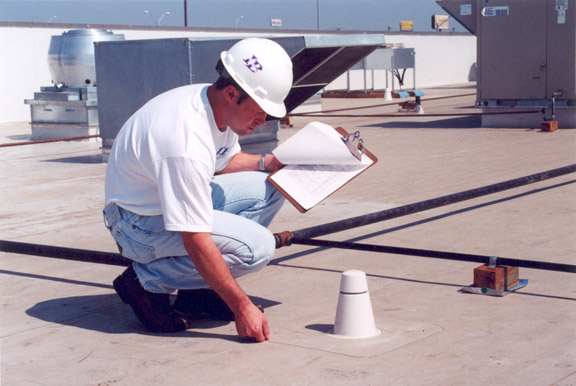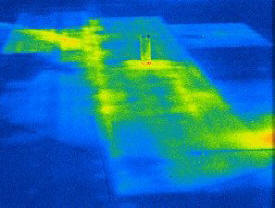How to Implement A Roof Maintenance Program:
Roof-Advisor.com, LLC makes it easy for a building owner to institute a semiannual maintenance program to maximize their roofing investment. The roofing products used by us are manufactured to Miami-Dade codes in a factory under strict quality controls. They are often covered by warranties that actually call for periodic maintenance inspections and provisions. In fact, warranties can be voided by the lack of regularly scheduled roof inspections and maintenance.
Periodic preventive maintenance can prevent small, easily handled problems from becoming disruptive, big-budget nightmares. Proper repairs to a roof system can prolong the roof's service life and enhance the value of the original investment made in it. Maintenance issues are attracting more attention these days from the roofing industry as a whole, but especially in Florida's roofing areas. Roof-Advisor.com, LLC has set up roof maintenance and/or roof management programs to handle these concerns in an ongoing, professional way, freeing facility managers to concentrate on other areas. Regular inspections of the roof system should be made in both the fall and the spring; special inspections should also be made when extraordinary events occur, such as extreme storms or the installation of new rooftop equipment.
Basic roof inspection procedures
Perhaps surprisingly, the starting point of a roof inspection should actually be the interior of a building. The interior walls and ceilings should be examined for any signs of water staining which would indicate a problem above on the roof.
The roof itself should then be visually inspected.
The following key areas should be checked in this order:
* Cap flashings
* Edge metal
* Base flashings
* Penetrations
* Field of the roof
* Ballast
* Roof adhesives; and Surface coatings, if present.
Cap flashings, which are metal or other rigid covers at
membrane terminations, should be inspected for:
* loose areas of attachment or loose or missing fasteners
* loose or displaced sections of metal
* deformed metal that could collect water and funnel it through an end joint
* corrosion
* missing or loose joint covers
* sealants showing signs of cracking, weather and/or aging.
Edge metal, installed at the edge of a roofing system
to terminate the roof and provide waterproof flashing, should be checked for:
* loose areas of attachment or loose or missing fasteners
* loose or missing stripped-in flashing
* splits in the stripping at metal flashing joints
* corroded metal
* missing or displaced metal sections or joint covers
* open joints and sealants displaying signs of cracking or weathering or aging.
Base flashings, which are roof membrane terminations
at walls and curbs, should then be looked at. Watch for:
* a secure and sealed top termination
* continuous adhesion of base flashing to substrate, with no loose membrane or extensive bridging
* a covered top seal of the membrane base flashing
* closed seams at the bottom of the base flashing at its attachment to the field membrane
* sealed seams at vertical laps
* sealants in good condition, without signs of cracking, weathering or aging
* base flashing material without signs of deterioration or building movements.
Penetrations are pipes, drains and other items that are inserted through the roof membrane. They must be flashed properly to assure a watertight roof. An inspector should examine the following:
* the drain clamping ring and drain strainer to ensure proper securement for a watertight seal at the membrane-to-drain interface
* thorough adhesion of sealant inside pitch pockets and membrane adhesion around the outside of pitch pockets
* pitch pockets containing adequate fill material to prevent water from collecting
* pipe boot flanges sealed tightly to the roof membrane
* a tight seal and termination around pipe(s) at the top of pipe boots.
In the field of the roof, be sure that:
* No fasteners protrude against the membrane, causing a "tenting" effect; or that there are no visibly loose fastening points
* the membrane contains no worn spots, deteriorated areas, or holes in the membrane
* insulation panels are in their original positions: no buckling or warping
* there are no changes in insulation or substrate firmness when the roof is walked on
* adequate drainage is present
* around rooftop equipment, no areas have been degraded by equipment leaks or spills, or have been punctured by dropped tools or equipment parts from workers maintaining roof-mounted equipment.
In ballasted systems, it is important to note:
The removal of ballast or concrete pavers to inspect the membrane is not part of a routine inspection. Ballast, if present, should be continuously redistributed, although occasional small bare spots, approximately the size of a person's foot, are generally acceptable. Use a push broom as necessary to cover the membrane and prevent uneven loading.
If the roof membrane has a coating on it, it should be examined. Coatings will generally require reapplication(s) during the life of the roof system; frequency depends on many factors, such as the local environment, ponding water, roof slope, and the type and quality of the original coating. Recoating work is typically the responsibility of the building owner and should be performed by a professional roofing contractor. The inspector should also pick up debris like paper, bottles, broken glass, tree limbs and vegetation and dispose of it properly. Likewise, he should also remove obstructions, such as leaves or dirt from roof drains and/or scuppers, ensuring that they flow freely. Clogged drains and/or scuppers can lead to excessive ponding on the roof, which frequently causes leaks or even roof collapse. Caution should be exercised when clearing debris from drains because significant suction can be created by draining water; it can quickly suck tools into a drain. If traffic patterns are developing across the roof, the owner should consult the membrane manufacturer to determine how to best protect the roof membrane from traffic. A number of different walking pads or systems are available to address this issue. Roof inspection may uncover the need for repairs in a variety of categories, including spot patches, emergency repairs, general repairs and permanent repairs.
If membrane repairs are needed, they should be performed by a professional roofing contractor specifically authorized by the membrane manufacturer. Not doing so could also void the warranty. And in keeping with typical warranty requirements, the manufacturer of a warranted roof system should be notified promptly about the need for repair(s) and the procedures to be followed. Typically manufacture warranties require written notification to the warranty department within thirty (30) days of discovery of any leak. All procedures should be documented in order to create an informative history of a roof system's performance.
Roof-Advisor.com, LLC can develop a roofing maintenance program for you.
Tips:
* Keep roof clean and free of debris.
* Keep drainage systems clear and functional.
* Train maintenance personnel in the do's and don'ts of single plies.
* Restrict roof access to authorized personnel only.
* Limit penetration of the roof system for later equipment installation.


